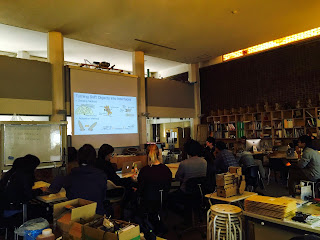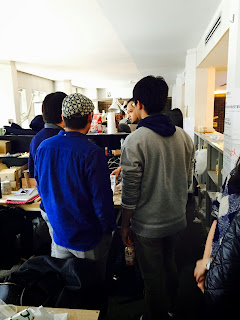| Preparing preliminary design options |
| Volumetric Models |
| Meeting with Prof. Kuma at KKAA |
Professor Jun Sato gave a comprehensive structures lecture for the first year students. He showed the students many renowned projects and experiments that has pushed the boundaries of structural engineering possibilities.
After which, each student team conducted a bending moment test and Prof. Sato advised them on calculations, further tests, and possible improvements.
In the future, these collaborators and experts will join us as jury members to select the final design for this year’s 2015 DFL research pavilion.
On April 10th, we had an Arduino workshop and invited Yuta Sugiura from Keio University. The goal of the workshop was to build “smart tools” in just an hour.
| Arduino Introduction |
| Students making their own “smart tools” |
| Testing servos |
| Connecting cables |
| Mounting circuits on the “smart tool” |
At the end of the workshop, we had presentations.
| Interactive washing puff – it measures the distance between the machine and a wall. It also measures worker stress by measuring the loudness of workers’ voices. |
| Smart spray for grafitti artists – this enables the painter to create a brush-like feeling by controlling the discharge rate (depending on the distance between the wall and the spray). |
| Smart detergent dispenser – it detects dirt by checking the brightness of the wall. |
On March 16th, four design teams of 2nd year students had their Mid-term thesis presentations! Each team was given 15 minutes to present core scenario of their projects using both 3 minutes video and slide format presentation. The presentations were followed by a 20-minutes of discussion. As reviewers, David Erdman of the University of Hong Kong, Yutaro Muraji of Keio University, Gabriel Cira who currently works in Arata Isozaki’s office and Kae Miyazawa from Department of Global Agricultural Sciences at the University of Tokyo joined us for these presentations.
Sato sensei gave the kick-off structural engineering lecture for the first year students. We are planning various material tests (e.g. bending, compression, and buckling). Each project has its own design and material property thus it is important to listen the expert to decide which test is suitable.
Sugiura-san, a visionary researcher in tangible computer interaction, gave a lecture about his previous works including Graffiti Fur. .jpg)
.jpg)

With the advancement of technology, data has become readily available and easy to produce, while material resources and traditional craft are disappearing from our contemporary life. With Japan’s declining population, skilled labor in the building sector is projected to be insufficient to maintain and produce the architecture of the future with quality that Japan is known for. Thus, our approach is to integrate Information distribution technologies with human tasks. We seek to utilize methods of human augmentation to create a dynamic system of distributed 3D printers capable of “printing” a large-scale, on-site, formwork-less structure.
Our proposal is a network of human-driven 3D printing devices, which we call STIK (Smart Tool Integrated Konstruction). The basic component for the system is a chopstick, ‘waribashi’ which is a recycled material collected from an industrial chopstick production process. By controlling the way that these sticks are locally distributed, we can aggregate them into a specific geometry that is inherently stable. A scanning system monitors the printing process, sending data to the network, which is compared to the overall digital target geometry. The network then feeds back to each distribution node, controlling the progress of the structure.